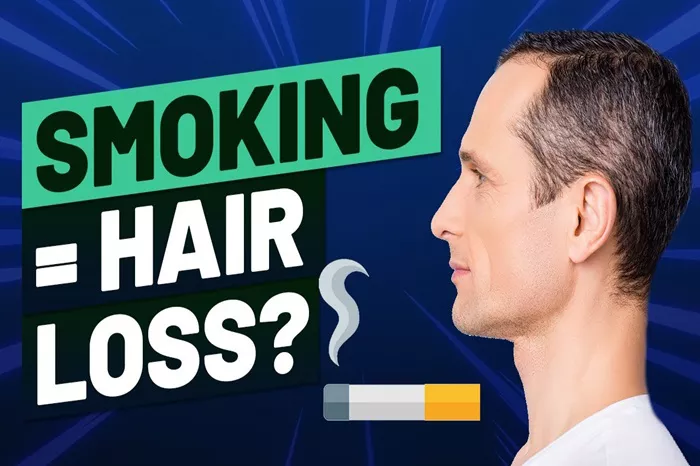Smoking is a well-known health hazard. It is associated with numerous diseases and conditions, such as lung cancer, heart disease, and respiratory issues. However, smoking’s impact on hair health is less widely discussed but equally concerning. This article delves into how smoking contributes to hair loss, examining the mechanisms involved and providing practical advice for those affected.
Understanding Hair Growth and Hair Loss
The Hair Growth Cycle
Hair growth occurs in a cycle consisting of three phases:
Anagen Phase: The growth phase lasting 2-6 years.
Catagen Phase: The transitional phase lasting about 2-3 weeks.
Telogen Phase: The resting phase lasting about 3 months, after which hair falls out and a new cycle begins.
Causes of Hair Loss
Hair loss can result from various factors, including genetics, hormonal changes, medical conditions, medications, and lifestyle choices, such as smoking.
SEE ALSO: What Does Unhealthy Curly Hair Look Like?
The Link Between Smoking and Hair Loss
Reduced Blood Flow to Hair Follicles
Smoking constricts blood vessels, reducing blood flow. Hair follicles need a rich supply of nutrients and oxygen to maintain healthy growth. Reduced blood flow means hair follicles receive fewer nutrients and less oxygen, leading to weaker hair and increased shedding.
Damage to Hair Follicles
Toxins in cigarette smoke can directly damage hair follicles. These toxins cause oxidative stress, leading to cellular damage and inflammation. Over time, this damage can impair hair follicle function, resulting in hair loss.
Hormonal Imbalance
Smoking can disrupt the balance of hormones in the body. Hormonal imbalances, particularly involving androgens (male hormones), can contribute to hair loss. High levels of dihydrotestosterone (DHT), a potent androgen, can shrink hair follicles and shorten the hair growth cycle, leading to thinning hair and hair loss.
DNA Damage
The chemicals in cigarette smoke can cause DNA damage in hair follicle cells. This damage can affect the cell’s ability to function and replicate properly, leading to weakened hair structure and increased hair loss.
Reduced Nutrient Absorption
Smoking can impair the body’s ability to absorb essential nutrients. Vitamins and minerals such as Vitamin C, Vitamin E, and zinc are crucial for hair health. A deficiency in these nutrients due to smoking can weaken hair and lead to hair loss.
Smoking-Induced Conditions Contributing to Hair Loss
Telogen Effluvium
Telogen effluvium is a condition characterized by temporary hair shedding due to stress on the body. Smoking can exacerbate this condition by increasing oxidative stress and inflammation, pushing more hair follicles into the telogen (resting) phase prematurely.
Androgenetic Alopecia
Androgenetic alopecia, also known as male or female pattern baldness, is a common cause of hair loss. Smoking can accelerate this condition by increasing levels of DHT and causing vascular issues that affect hair follicle health.
Alopecia Areata
Alopecia areata is an autoimmune condition where the immune system attacks hair follicles. Smoking can trigger or worsen autoimmune responses, potentially leading to alopecia areata and subsequent hair loss.
Scientific Studies Linking Smoking and Hair Loss
Study 1: Smoking and Male Pattern Baldness
A study conducted by the Harvard School of Public Health found that men who smoke are more likely to experience severe hair loss than non-smokers. The study suggested that smoking’s impact on blood circulation and the release of harmful chemicals could be contributing factors.
Study 2: Smoking and Female Hair Loss
Research published in the Journal of Dermatological Science indicated that women who smoke have a higher risk of developing diffuse hair loss. The study highlighted the role of smoking in hormonal imbalances and oxidative stress.
Study 3: Cellular Damage in Hair Follicles
A study published in the British Journal of Dermatology found that smokers have higher levels of DNA damage in hair follicle cells. This damage was associated with increased hair follicle miniaturization and hair loss.
Practical Tips to Prevent Smoking-Related Hair Loss
Quit Smoking
The most effective way to prevent smoking-related hair loss is to quit smoking. This can improve overall health and reduce the risk of hair loss.
Improve Nutrition
Ensure a diet rich in vitamins and minerals essential for hair health. Foods high in antioxidants, such as fruits and vegetables, can help combat oxidative stress.
Reduce Stress
Stress can exacerbate hair loss. Engage in stress-reducing activities such as exercise, meditation, and adequate sleep.
Use Hair-Friendly Products
Choose hair care products that are gentle and free from harsh chemicals. Products containing ingredients like biotin, keratin, and essential oils can support hair health.
Consult a Dermatologist
If you are experiencing significant hair loss, consult a dermatologist. They can provide a proper diagnosis and recommend treatments such as minoxidil, finasteride, or other medical interventions.
Conclusion
Smoking is a significant risk factor for hair loss. It affects hair health through various mechanisms, including reduced blood flow, follicle damage, hormonal imbalance, DNA damage, and nutrient deficiencies. Quitting smoking is the best step to prevent further hair loss and improve overall health. Adopting a healthy lifestyle, managing stress, and using appropriate hair care products can also help mitigate hair loss. If hair loss persists, seeking professional medical advice is crucial for effective treatment. Taking proactive measures can lead to healthier hair and a healthier life.

